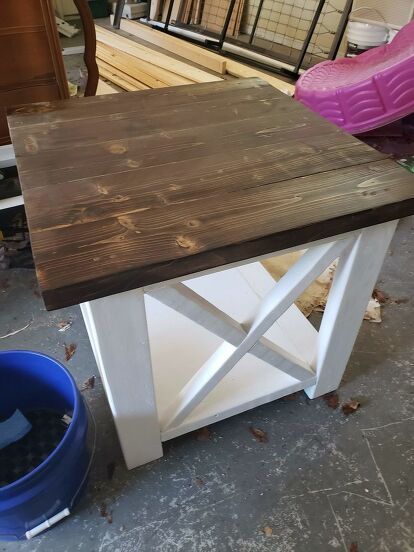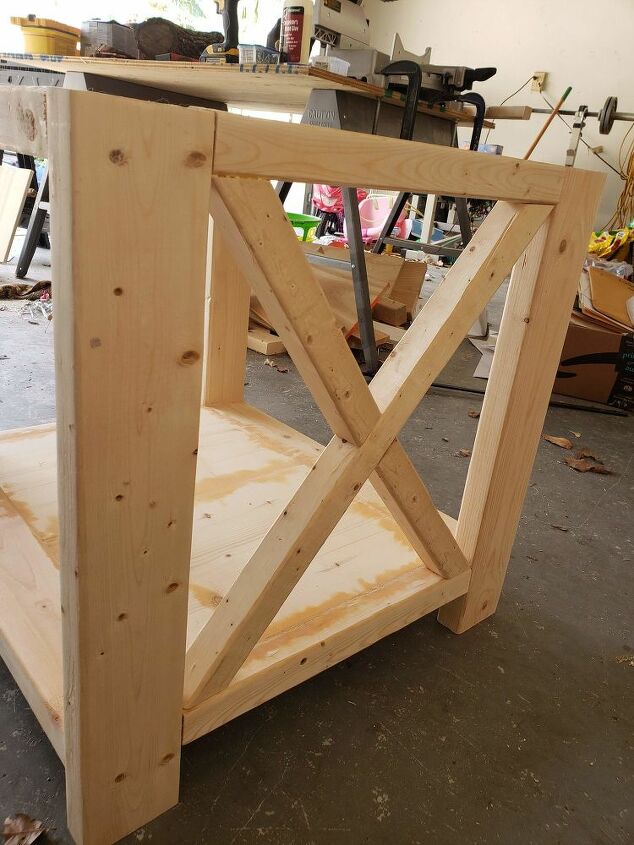DIY Rustic Farmhouse Tables

Step 4: Attaching the X
I found it really helpful to clamp my 2×2 into place and then trace the cuts with a pencil. That way, it fit perfectly! Attach with wood glue and normal wood screws. These are mostly decorative.
I found it really helpful to clamp my 2×2 into place and then trace the cuts with a pencil. That way, it fit perfectly! Attach with wood glue and normal wood screws. These are mostly decorative.
Step 6: Build your table top.
Using 1 1/2″ pocket holes and 2 1/2″ pocket hole screws, build your table top. I clamped as I went until my clamps ran out of space!
Using 1 1/2″ pocket holes and 2 1/2″ pocket hole screws, build your table top. I clamped as I went until my clamps ran out of space!
Fill in all holes with wood filler and sand smooth!
Step 7: Paint or Stain
I painted the base and stained the top, so I didn’t actually attach the top to the base until after the base was fully painted and the table top was fully stained. I’m a fairly messy project person, so I wasn’t confident I could keep the two pieces cleanly apart!
I painted the base and stained the top, so I didn’t actually attach the top to the base until after the base was fully painted and the table top was fully stained. I’m a fairly messy project person, so I wasn’t confident I could keep the two pieces cleanly apart!
For the look I was going for (distressed), I painted a base coat of dark gray.
Then, my other helper assisted with painting the top coat of white.
I stained the table top with Minwax Dark Walnut, wiping it off within the first minute of it going off. When both the base and table top were finished, I attached the table top to the base using normal wood screws. I filled in the holes with wood filler and did a quick touch up with the stain.
Step 8: Distress and Seal
They wanted a really distressed look, so I distressed the white paint off using a combination of hand and mouse sanding with 120-220 grit sandpaper.
For the base, I wanted it to look fairly rustic, so I chose a matte, water based polyurethane to seal. For the table top, I used the shinier oil based poly to seal. Apply your first coat and let it dry. Then, sand it and apply a second coat once the sanding dust has been cleaned off.
They wanted a really distressed look, so I distressed the white paint off using a combination of hand and mouse sanding with 120-220 grit sandpaper.
For the base, I wanted it to look fairly rustic, so I chose a matte, water based polyurethane to seal. For the table top, I used the shinier oil based poly to seal. Apply your first coat and let it dry. Then, sand it and apply a second coat once the sanding dust has been cleaned off.
Step 9: Attach leveling feet.
Despite seeking out the straightest boards, my pine furniture involving table tops usually comes out just slightly off – everything is level until I attach the table top. So, to combat that issue, I have attached leveling feet to the legs!
Shown here is the matching coffee table’s leg, but I used the same style of feet on each table. You can adjust them so that the table does not wobble and it has been a life saver for me!
Despite seeking out the straightest boards, my pine furniture involving table tops usually comes out just slightly off – everything is level until I attach the table top. So, to combat that issue, I have attached leveling feet to the legs!
Shown here is the matching coffee table’s leg, but I used the same style of feet on each table. You can adjust them so that the table does not wobble and it has been a life saver for me!
What you end up with is a beautiful, super sturdy and level side table! You can add decorative hardware to spice it up even more, or just leave it rustic looking. They are in LOVE with their set! I loved it so much I wanted to keep it myself –  .
.
 .
.










